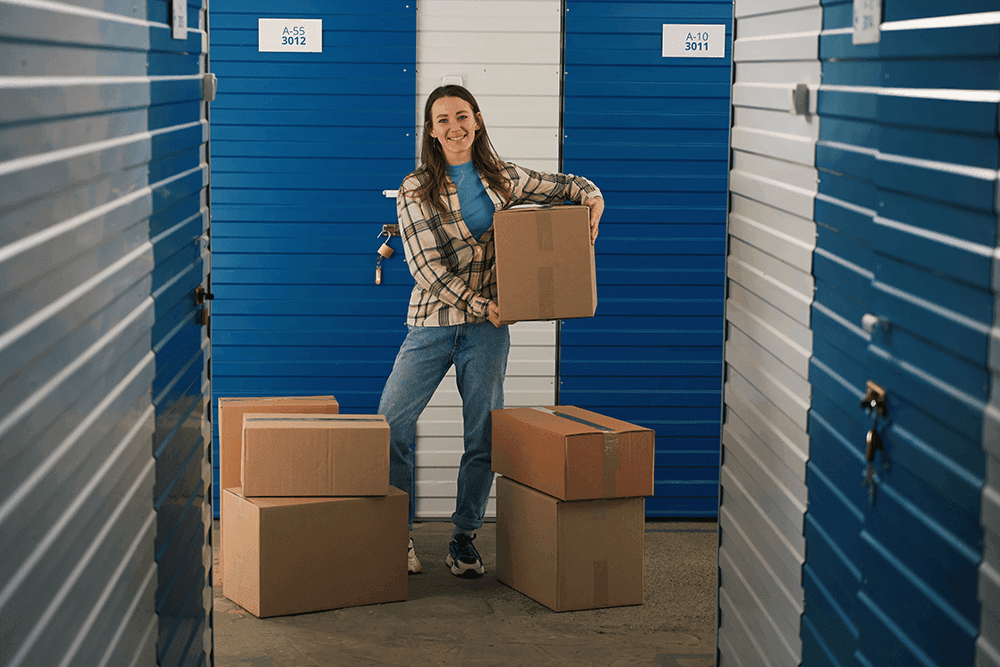
 Packing Tips
Packing TipsHow to Prevent Mold in Storage Containers
Mold is a common issue that can impact your belongings in many adverse ways. Thankfully, though, there are steps that you can take to keep your bins safe from this problem. Many of these steps are designed to work in facilities that do not have storage with electricity. However, some items can be used to protect facilities that do have power, so keep them in mind.
Preparing Your Containers
Before you ever start putting anything in your storage facility, it is crucial to prepare them to keep them safe from mold. Often, a mold infection begins in your containers and spreads out from there. Thankfully, there are several steps to take here that help to disinfect the sides of the container and keep mold from growing. The first of these involves pouring white vinegar into a plastic spray bottle and then spraying the inside of the box as much as possible.
This vinegar will disinfect the sides and kill any mold spores that may be threatening to grow there. Just as importantly, this vinegar can kill any other bacteria that may want to grow inside your containers. This bacteria can spread rapidly and cause issues with your boxes that can be almost as bad as mold. Wipe off the white vinegar after five minutes before moving on to the next step.
Now, when you start putting items in the container, make sure that they are dry and hygienic. All clothes should be washed and dried before folding them and storing them. Other things should similarly be prepared using whatever methods are appropriate. Make sure to stack these items carefully on top of each other to minimize any extra room where the mold could grow on the sides.
Lastly, place a small item to absorb moisture and keep mold from spreading. For example, a baking soda box can help prevent mold from spreading out of your containers and to the rest of your storage facility. If you don't have room for a baking soda box, you can place a drop of grapefruit seed extract on a cotton ball. Place this ball in the container, and mold shouldn't be a problem for you.
Waterproofing the Storage Facility
Though much mold growth in storage facilities occurs from the containers, a large amount may also spread from the outside. As a result, it is essential to take steps to keep your storage room safe from this problem. The first of these steps that you should consider is setting up a vapor barrier in your unit that helps prevent water from getting inside and causing any mold.
A vapor barrier is a straightforward item that you can install in many ways. First of all, you can place it over your items to stop mold from getting to them. You must make sure to tuck this cover under each storage bin's edges to avoid any complications. However, you can install this plastic barrier directly to the walls to keep any water from getting into your storage facility.
This step is going to take more time to finish but provides more protection. Talk to your storage facility manager about this step before taking it – some may not allow you to change the interior of your bin in this way. Other steps that you can take focus less on preventing moisture but absorbing it when it does occur in your storage bin.
For example, you can place large bags of silica gel throughout the center to absorb moisture. However, if you don't have access to this type of gel, charcoal can do the same thing. Place a small basket of charcoal in your bin, and it will absorb water. You may want to add multiple baskets, change them out every month, or ensure that your container is as moisture-free as possible.
How Do You Keep Moisture Out of Storage Containers?
Using moisture-absorbing products like desiccant packets or silica gel to keep moisture out of storage containers. Ensure your items are completely dry before storing them, and consider placing a moisture barrier like plastic sheeting at the bottom of the container. Using airtight containers and proper sealing also helps prevent moisture infiltration.
Do Airtight Containers Prevent Mold?
Airtight containers can help prevent mold by minimizing air and moisture exchange between the container and its surroundings. However, they are not foolproof. It's essential to ensure items placed inside airtight containers are completely dry, as any trapped moisture can promote mold growth.
How Do You Prevent Mold on Plastic?
To prevent mold on plastic items, clean and dry them thoroughly before storage. Use moisture-absorbing products like silica gel or desiccant packs. Maintain a controlled environment with stable temperature and humidity levels, and inspect stored items periodically for any signs of mold growth.
How Do You Ventilate a Storage Container?
Ventilating a storage container involves creating airflow to prevent moisture buildup. You can achieve this by leaving a small gap or opening in the container, allowing air circulation. Be mindful of the potential for pests entering through the opening and take appropriate precautions.
What Kills Mold and Mildew on Plastic?
Mix a solution of equal parts white vinegar and water to kill mold and mildew on plastic. Apply this mixture to the affected areas and scrub with a soft brush or cloth. Alternatively, hydrogen peroxide can also be effective in eliminating mold and mildew. Ensure the plastic is thoroughly dry before returning it to storage.
How Does Mold Get into Sealed Containers?
Mold can get into sealed containers if the items placed inside are not entirely dry or there is residual moisture. Additionally, if the container is not sealed correctly, small gaps or imperfections can allow mold spores to enter. Proper sealing and ensuring items are dry are key factors in preventing mold growth in sealed containers.
Other Techniques to Consider
If charcoal and vapor barriers aren't available or you want to save money, you can consider many other techniques. For example, there are many moisture-absorbing products available that can keep mold out of your bin. These include items like activated alumina, sodium chloride, and more. Handle and use these items carefully because they can be dangerous and toxic.
Another step that you can take is adding a bin or two of kitty little to your storage bin. Kitty litter naturally absorbs moisture and can keep your storage bin from getting moldy. It does need to be changed every week or so but can be an inexpensive way to prevent mold from affecting your belongings. You can get more out of this step by opening up a full bag and leaving it in your bin instead of just a small container.
If your facility sends electricity to your bin, you can also use a dehumidifier or a fan to keep your facility from the mold. A dehumidifier removes excess water and must be changed frequently, which does somewhat limit its usefulness. And a fan will move air and keep it from settling, stopping many types of mold growth. However, centers with electricity also often have climate control options.
Get Climate Control Units for Extra Protection
Though climate control units are more expensive than traditional storage bins, they are a significant investment. They use a variety of temperature and moisture management techniques to keep mold from growing. You can still use the methods mentioned above in these bins for extra protection, though, so consider them before storing any items. In some cases, it is critical to use as many steps as you can to prevent mold.
We're Your Storage Solution!
Storage Rentals of America is your convenient self-storage solution. So come into our office or give our storage experts a call at 1-800-457-5678. Our call center is available 7 days a week and can help determine which storage unit size best fits your storage needs.



